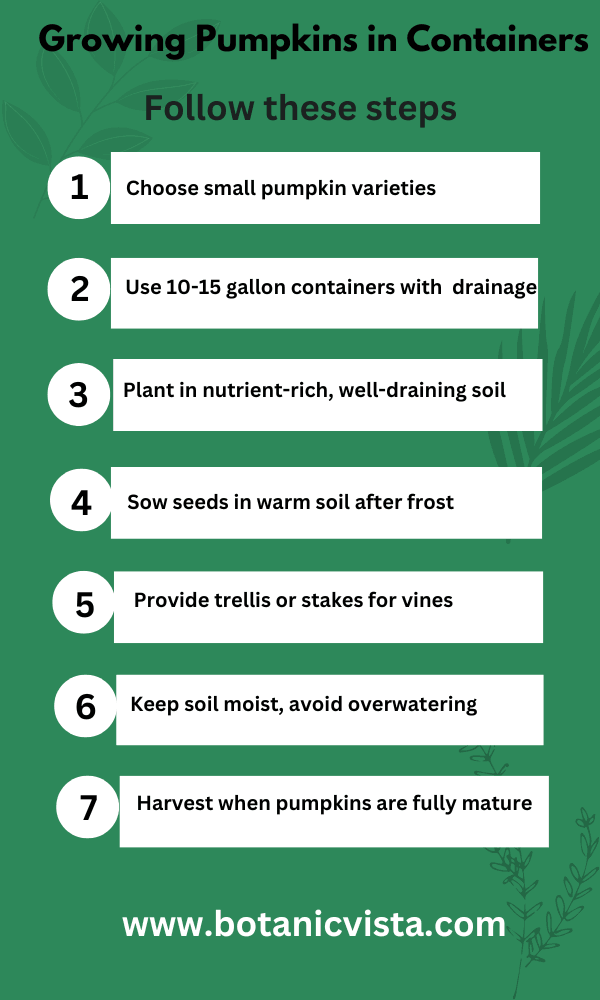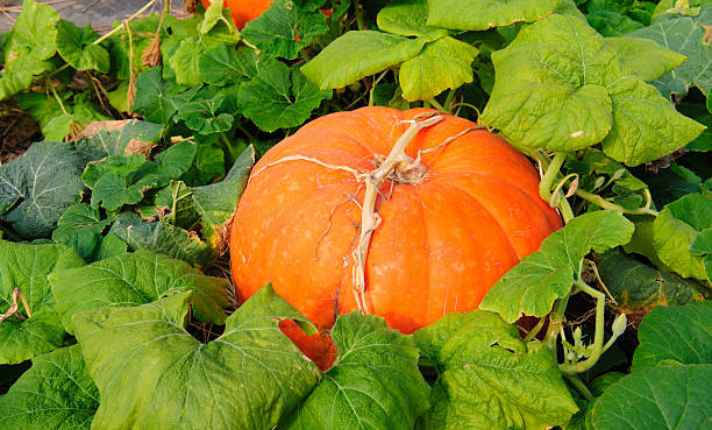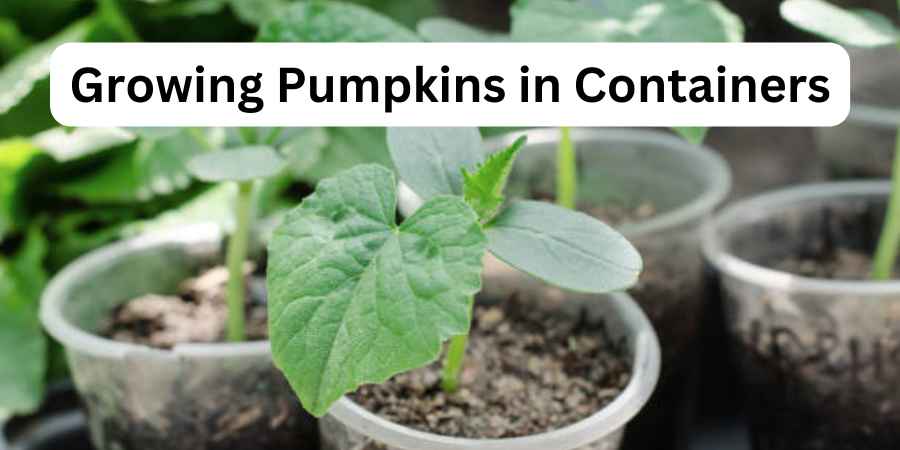Last Updated on November 29, 2024 by Jocelyn
Growing pumpkins in containers is a wonderful way to enjoy gardening in small spaces. Whether you have a balcony, patio, or rooftop, you can grow your own pumpkins at home. This guide will help you get started with just a few simple steps.
First, choose the right container. Your pumpkin needs space to grow, so pick a pot that holds at least 10 gallons of soil. Place your container in a sunny spot to ensure your pumpkin gets enough light.
Next, decide which variety of pumpkins you want to grow. Some types are perfect for carving, while others are best for cooking or decoration. Plant the seeds about an inch deep, water them regularly, and make sure they get plenty of sunlight.
Caring for your pumpkin plants involves regular watering and keeping an eye out for pests. With consistent care, your pumpkins will grow healthy and strong. When autumn arrives, you’ll be ready to harvest your own pumpkins.
In this article, we will explore how to select the best varieties, provide planting and care tips, and share the joy of harvesting your homegrown pumpkins.

Table of Contents
ToggleChoosing the Right Pumpkin Variety
For container gardening, select pumpkin varieties that fit small spaces. Baby Boo is an excellent choice. It’s a miniature pumpkin with a compact growth habit. Its white skin and sweet flesh are perfect for small gardens.
These pumpkins typically grow to about 2-3 inches in diameter.
Sugar Pumpkins are also great. They have bushy vines and flavorful flesh. These pumpkins are ideal for cooking and usually reach about 6-8 inches in diameter. Their compact size makes them suitable for containers.

Miniature Pumpkins offer variety. They come in different colors and shapes, usually growing to about 2-4 inches in diameter. These small pumpkins are easy to manage and add a decorative touch to your garden.
Choosing the right pumpkin helps you make the most of your container garden. Select varieties that are well-suited for small spaces. Enjoy growing your own pumpkins even in limited areas.
Selecting the Right Container
When choosing the right container, there are some important things to think about.
Pumpkins can grow in many types of containers. You can use a 20-gallon or even a 36-gallon container. If you are unsure, a 10-gallon container might work for smaller, miniature pumpkins. Plastic containers are often the best choice because they are light and easy to move.
If you want to grow bigger pumpkins, a 6-foot-wide swimming pool or a large 25-gallon container is perfect. Some gardeners even use raised beds.
These can be better because they give the roots more room. A 5-gallon bucket is too small for most pumpkins, but it can be used for tiny ones.
Grow bags are also a great option. For medium-sized pumpkins, a 10-gallon grow bag is a good choice. Always look at the volume and height of the container. Make sure it is at least 20 to 25 inches tall.
A typical pumpkin vine can stretch across a large area, so give it enough space. If you use a big container, your pumpkins have more potential to grow well. Some gardeners even use a 6-foot-wide children’s pool!
If you have a small space, like a patio or balcony, containers are a great way to grow pumpkins. This method also helps keep pests away and makes it easier to control the soil and water.
Always look for containers that are big enough for the type of pumpkins you want to grow.
How to Plant Pumpkins in Containers
Planting pumpkins in containers lets you grow pumpkins even if you have a small space. With proper preparation and care, you can enjoy fresh pumpkins from your own patio or balcony.
Follow these easy steps to get started.
1. Choose the ideal Container
Select a large container with drainage holes to prevent waterlogging. A container that holds at least 10 gallons of soil is ideal for growing pumpkins.
2. Prepare the Soil
Fill the container with high-quality soil mixed with compost and a bit of aged manure. This mixture provides the nitrogen and phosphorus needed for healthy pumpkin growth.
3. Plant the Seeds
Plant your seeds about 2-3 inches apart and 2-3 inches deep. Cover them lightly with soil.
4. Create Warmth
Cover the container with plastic wrap or a plastic bag to retain warmth and moisture. Place the container in a sunny spot to help the seeds sprout.
5. Care for Seedlings
Once the seedlings are 2-3 inches tall, remove the cover. Thin the seedlings to ensure they have enough space to grow. Keep the soil moist but not soggy. Use a water butt to collect rainwater for watering.
6. Provide Support
As the vines grow, use a trellis or other support to keep them upright and improve air circulation. This helps prevent mold and pests.
7. Fertilize Monthly
Fertilize the soil monthly with a balanced fertilizer to ensure the plants receive the nutrients they need to produce healthy pumpkins.
8. Monitor and Maintain
Regularly check for pests and remove any you find. Ensure the soil remains moist but not waterlogged to avoid root rot. With these steps, you can successfully grow pumpkins in containers.
Explore my other guides for practical tips on pot/container gardening:
Caring for Your Pumpkin Plants
Caring for your pumpkin plants involves ensuring they receive the right amount of water, sunlight, and nutrients. Regular monitoring of pests and diseases is crucial to keep them healthy.
Supporting the vines and proper pruning can enhance fruit production and prevent damage. By following these steps, your pumpkins will grow strong and productive in their containers.
- Watering Requirements
Water your pumpkins regularly, ensuring the soil is consistently moist but not soggy. Check the soil frequently to keep it at the right moisture level.
It’s crucial to keep the soil moist without making it waterlogged. Overwatering can lead to root rot, so water is just enough to maintain moisture.
- Fertilization
Choose a balanced fertilizer that provides equal amounts of nitrogen, phosphorus, and potassium to ensure your pumpkin plants get all the necessary nutrients. Fertilize your pumpkins at the right stages of growth.
Start with a general all-purpose fertilizer and later switch to one that supports flower and fruit development. Consider using organic fertilizers like compost and manure.
These improve soil structure and provide essential nutrients without the risk of chemical buildup. Add micronutrients such as iron, zinc, and magnesium to your soil to support healthy plant growth and fruit production.
- Light and Temperature
Pumpkin plants need lots of sunlight. Place your container in a bright spot where it can receive at least six hours of direct sun daily. If growing indoors, ensure your plants get enough light by placing them near a sunny window or using grow lights to mimic natural sunlight.
- Support and Pruning
Use a trellis to support the vines and keep the fruit off the ground. This helps prevent pest problems and allows better air circulation. As your vines grow, train them to climb the trellis.
Secure the vines with soft cotton ties to prevent damage and ensure they grow upright. Prune your plants by removing excess flowers to allow the plant to focus energy on developing fewer but healthier pumpkins.
- Pest and Disease Management
Regularly check your plants for signs of pests like aphids and mites and for diseases such as powdery mildew. Use organic pest control methods like insecticidal soap or neem oil to manage infestations and keep your plants healthy.
By following these steps, you can successfully grow pumpkins in containers, ensuring they stay healthy and productive throughout the growing season.
To learn more about growing flowers, explore further:
Harvesting Your Pumpkins
In autumn, when the temperature cools, the vines will wither and die back. This is a sign the pumpkins are ready to be picked. Check the color and make sure the rind is hard.
If you can’t puncture it with your fingernail, it’s ripe. Use pruners or a knife to cut the pumpkin off the vine, leaving a long stem. This helps keep the pumpkin fresh.
Put the pumpkins in a warm, dry place for 2-3 weeks to cure. This makes the skin tough and helps it last longer. Store them in a cool, dry spot like a garage or cellar.
Keep them away from direct sunlight and humidity to avoid rot. Growing pumpkins in containers gives you tasty pumpkins even if you have limited garden space.

FAQ’s
Q: How Many Pumpkins Will I Get Per Plant?
A: The number of pumpkins you get per plant depends on the variety. Mini pumpkins can produce up to five pumpkins per vine, while standard pumpkins typically yield one to two pumpkins per vine.
Q: What Month to Plant Pumpkins?
A: Plant pumpkins in May or June and have them ready by October. Choose faster-growing varieties for containers. In my experience, starting in mid-May ensures fully developed plants.
Q: Do Pumpkins Come Back Every Year?
A: Pumpkins do not come back every year on their own. They need to be replanted each growing season.
Q: Will Pumpkins Grow in Potting Soil?
A: Yes, pumpkins can grow in potting soil. Use a mix of compost and slow-release fertilizer to provide plenty of nutrients. Raised beds also help roots grow strong with a rich mixture of soil and compost.
Q: Where Is the Best Place to Plant Pumpkins?
A: Choose a sunny location with fertile, well-drained soils. Before planting, add organic matter and a complete fertilizer. Plant four to six seeds 1-2 inches deep in small mounds and space them a few feet apart.
Conclusion
Growing pumpkins in containers is a great option if you don’t have a large yard. Use a big pot, good soil, and some fertilizer. Regular watering and plenty of sunlight are essential. Watching them grow and eventually harvesting them is very rewarding.
With a bit of care and attention, you’ll be amazed at how well your pumpkins do in containers. This method is practical and allows you to enjoy fresh pumpkins right from your home. Give it a try, and enjoy the results of your efforts!

